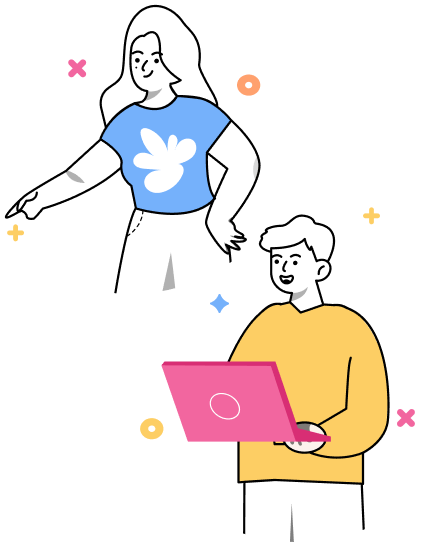13 Fun Virtual Instructor Led Training Activities
Virtual activities promote a dynamic learning environment where students actively engage with the material. Check out these 13 activities you can use to keep students engaged.

13 Fun Virtual Instructor Led Training Activities
Are you looking for ways to make your virtual training sessions more fun, engaging, and effective? You’re not alone. Educators face the challenge of delivering high-quality education in a virtual environment. How do you keep your learners motivated, focused, and involved when they’re sitting behind a screen?
To answer the question, we surveyed educators and training experts to come up with a list of the best virtual activities.
Run a quiz
Who doesn’t love quizzes? They feel less like class, and more like play. Quizzes make your virtual training more fun and engaging by adding an element of competition and gamification. They also improve information retention and academic performance.
You could use our Classroom Quiz deck as a starting point:
Brainstorm on a whiteboard
Brainstorming is a great way to get your creative juices flowing and come up with awesome ideas.
Whiteboards transform lectures. Instead of just listening to the teacher, students take active part in the discussion, share their thoughts, and learn to build on each other’s ideas. Meanwhile, teachers can adapt their lessons to the needs and interests of their students, and provide immediate feedback and support.
To brainstorm on a whiteboard, you can use an online tool like Miro to create, edit, and share digital whiteboards.
Host a live poll
Live polls are a fun and easy way to get your learners’ feedback and opinions. You can use them to check their understanding, spark a discussion, or just have some fun. Live polls also make your virtual training more interactive, as you can see and share the results in real time.
The Slides With Friend deck Poll Questions lets you host live polls with your students.
Students can join with any internet-connected device and vote on the questions you create. You can see the results as a chart or a word cloud, and get instant feedback from your students.
Breakout room conversations about the topic
A breakout room conversation is a small-group discussion that happens within a lecture. The teacher divides the students in groups and assigns them a topic. Each group has a limited time to discuss the topic and share their opinions or findings with the rest of the class.
Breakout room conversations increase learner engagement, collaboration, comprehension, and autonomy. But they need careful planning, facilitation, and monitoring.
A great tool for the job is Zoom, as it lets users host and join online meetings, webinars, and chat sessions.
Share educational videos
Videos are a terrific help for educators. Gone are the days of solely relying on textbooks and your own material to convey information to your pupils.
Teaching a science class about volcanoes? Send your students an animation about what happens inside a volcano when pressure starts building up.
Videos are not only informative, but also engaging and interactive. They can capture the attention of your students and spark their curiosity.
Whether you use videos from online sources or create your own, you can enhance your teaching and learning with this powerful tool.
Play a game with the class
Class doesn't have to be just lectures and note-taking. Infusing it with interactive elements like games can significantly boost engagement and learning.
For example, you could create a scavenger hunt game with Slides With Friends to teach geography:
Each slide could present clues about different countries or landmarks, and students would search online or in textbooks to find the answers.
We learn better when we’re having fun, which makes games a fantastic tool in any educator’s arsenal.
Organize a shadowing session with an expert
Shadowing involves following an instructor around as they perform a task the students should learn. The idea is to let the student witness how the skill applies to real-world situation.
Screen sharing tools like Microsoft Teams make this tool particularly effective in virtual settings. Instructors can guide trainees through tasks, providing live demonstrations and practical insights.
This method helps students understand the nuances of the skill in action, bridging the gap between theory and practice. It allows students to observe, ask questions, and get immediate feedback, which results in a deeper understanding of the skill.
Set up a peer review program among students
Peer review isn’t reserved to the upper echelons of academia. Have students review and provide feedback on each other’s work.
Digital tools like Google Docs facilitate this by allowing clear, extensive feedback and easy archiving of exchanges. It's a great way to build a community of learners who support and learn from each other, promoting deeper understanding and improvement in their work.
This interactive method not only enhances engagement but also develops essential skills in evaluation and constructive criticism.
Collaborate on a mind map
Mind maps are a powerful tool for visualizing ideas and concepts in the virtual classroom. They help students organize information, brainstorm, create solutions, and develop critical thinking skills.
Using a tool like Coggle, teachers can host mind mapping sessions where students collaboratively build and expand on ideas in a shared space. This interactive approach not only enhances engagement but also aids in the clear structuring and understanding of complex subjects.
Mind maps are a creative and effective way to visually connect thoughts and ideas, making learning more dynamic and memorable.
Organize a virtual field trip
Visiting museums and historical sites is an enriching experience for students. But traveling can be time-consuming and costly. With virtual field trips, you can bring these experiences right into the classroom.
This method uses online tools to virtually visit places of interest, combining education with the excitement of exploration.
For example, you could explore the pyramids of Egypt or the art of the Louvre without stepping outside. Virtual field trips let everyone with an internet connection experience the wonders of the world.
Create an interactive storytelling session
Do you know what’s better than reading a story? Taking part in one. Interactive learning increase students motivation, and storytelling adds another layer of immersion. This combination makes learning feel natural, effortless.
With Slides With Friends, you can turn storytelling into an engaging activity where students shape the narrative. Start with the Dungeons & Dragons deck:
Have students vote on what the characters should do next. This way, they learn to think critically about their choices in applying the material, rather than simply absorbing information.
Create a virtual escape room challenge
Escape rooms have become a popular way to engage and challenge participants, and you can bring this excitement to your virtual training sessions.
You can create one using online platforms like Slides with Friends or Genially. Choose a theme that matches your training goals, and design puzzles and tasks that test your learners’ knowledge and skills.
After the escape room, have a debriefing session to review the learning points and how they relate to the course content.
A virtual escape room challenge is an interactive and fun way to test your learners' problem-solving skills and knowledge retention while keeping them fully engaged.
Organize a live debate
Looking for a way to spice up your virtual training session? Give your students a stimulating challenge that will spark lively discussions and feedback by hosting a live debate among your students.
You can host a live debate with Slides With Friends. A solid starting point is the Independence Day deck, to which you will add a few "pass the mic" slides to give students the opportunity to talk:
As the instructor, you will moderate the debate. Have students discuss their points of view, share their arguments, and engage in a dynamic and thought-provoking debate. This activity teaches students to better communicate their ideas and respect other people’s perspective.
Embracing engaging virtual activities
Using fun and interactive virtual activities can make your training sessions much better. They work better than the old-fashioned classroom style.
Activities like live debates, interactive quizzes, and group mind mapping get students more involved and help them think better and remember what they learn.
Adding these activities to your teaching tools can make learning more fun, effective, and memorable for your students. With technology and creativity, you can keep your students interested and focused in the virtual classroom.


Ready to ditch the dull, and run team sessions that people will actually enjoy?
Get started with a Slides with Friends deck in no time. We’ve got all the interactive features you need in one easy-to-learn, easy-to-set-up tool.















